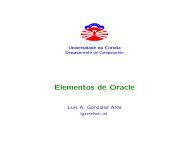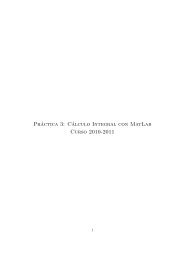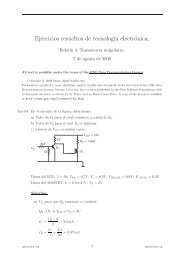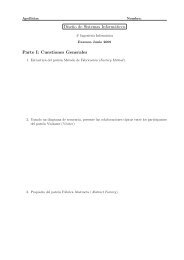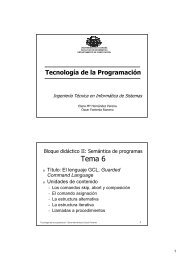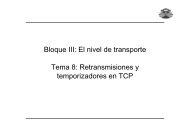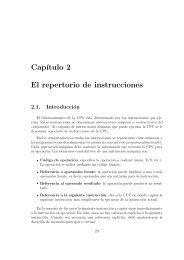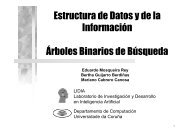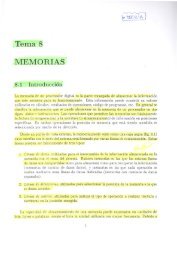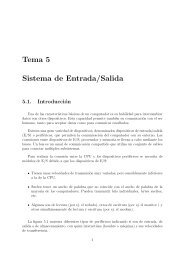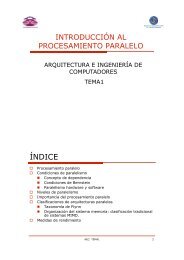Algunos ejercicios 1. Determinar si la siguiente ... - QueGrande
Algunos ejercicios 1. Determinar si la siguiente ... - QueGrande
Algunos ejercicios 1. Determinar si la siguiente ... - QueGrande
Create successful ePaper yourself
Turn your PDF publications into a flip-book with our unique Google optimized e-Paper software.
<strong>Algunos</strong> <strong>ejercicios</strong><br />
<strong>1.</strong> <strong>Determinar</strong> <strong>si</strong> <strong>la</strong> <strong>si</strong>guiente aserción de corrección parcial es cierta o no, mediante el <strong>si</strong>stema de prueba de<br />
<strong>la</strong> lógica de Hoare: { } { }<br />
i = j b[i] := 5 b[i] = b[j]<br />
2. Con<strong>si</strong>deremos el <strong>si</strong>guiente programa:<br />
{ PRE: x >= 0 }<br />
q := 0;<br />
r := x;<br />
while r >= y do<br />
(r := r - y;<br />
q := q + 1)<br />
end<br />
end<br />
{ POST: 0
Pero, <strong>si</strong> fuera cierta 1 se tendría:<br />
{<br />
}<br />
[ ] [ ]<br />
|= {T rue} b b[2] := 1 b b[2] = 1<br />
y como cualquer predicado implica True, se tiene que (b[1] = 2 ∧ b[2] = 2) ⇒ T rue y, por reforzamiento<br />
de <strong>la</strong> precondición<br />
{<br />
}<br />
{<br />
}<br />
[ ] [ ]<br />
|= b[1] = 2 ∧ b[2] = 2 b b[2] := 1 b b[2] = 1<br />
que contradeciría <strong>la</strong> certeza de <strong>la</strong> aserción de corrección parcial 2<br />
4. Con<strong>si</strong>deremos <strong>la</strong>s <strong>si</strong>guiente aserción de corrección parcial:<br />
{ True }<br />
x:=1; y:=1; c:=0;<br />
while y < 20 do<br />
y:= x+y;<br />
x:= y-x;<br />
c:= c+1;<br />
{ x = p(c)}<br />
{Inv: x = p(c) /\ y = p(c+1)}<br />
¿Qué propiedades debe cumplir <strong>la</strong> función p para que esta aserción sea cierta?<br />
Respuesta 2 Ha de verificarse:<br />
T rue ⇒ WP(x:=1; y:=1; c:=0, x = p(c) ∧ y = p(c + 1)) (3)<br />
de donde se obtiene que p(0) = p(1) = <strong>1.</strong><br />
Si, para <strong>si</strong>mplificar l<strong>la</strong>mamos C a (y < 20) y S a y:= x+y;x:= y-x;c:= c+1, con<strong>si</strong>deremos <strong>la</strong> reg<strong>la</strong><br />
{Inv ∧ C} S {Inv}<br />
reg<strong>la</strong> de Hoare del while<br />
{Inv} while C do S {Inv ∧ ¬C}<br />
Que se cump<strong>la</strong> <strong>la</strong> parte superior <strong>si</strong>gnifica que:<br />
(Inv ∧ C) ⇒ WP(S, Inv)<br />
es decir<br />
x = p(c) ∧ y = p(c + 1) ∧ y < 20 ⇒ y = p(c + 1) ∧ x + y = p(c + 2)<br />
para lo cual, bastará que<br />
p(c + 2) = p(c) + p(c + 1).<br />
Si esto sucede tenemos garantizado que, <strong>si</strong> se sale del bucle, en el momento de salir se verifica x = p(c)∧y =<br />
p(c + 1) ∧ y ≥ 20 que evidentemente implica x = p(c).<br />
2
5. Con<strong>si</strong>deremos el <strong>si</strong>guiente esquema de aserción de corrección parcial con un programa con dos bucles<br />
anidados y cada uno con su invariante:<br />
{P}<br />
c1;<br />
while b do<br />
(c2;<br />
while b’ do<br />
(c3);<br />
c5<br />
{Q}<br />
c4);<br />
{inv1}<br />
{inv2}<br />
¿Cuales son <strong>la</strong>s obligaciones de prueba?<br />
Respuesta 3 Las obligaciones de prueba son:<br />
a) inv2 es un invariante:<br />
inv2 ∧ b ′ ⇒ WP(c3, inv2).<br />
y como consecuencia, podemos poner <strong>la</strong>s anotaciones P1 y P2.<br />
{P}<br />
c1;<br />
while b do<br />
(c2;<br />
{inv1}<br />
P 1 : {inv2}<br />
while b’ do inv2 y esta aserción queda probada<br />
(c3);<br />
P 2 : {inv2 ∧ ¬b ′ }<br />
c5<br />
{Q}<br />
c4);<br />
b) inv1 es un invariante: 1<br />
1) P 2 ⇒ WP(c4, inv1)<br />
2) inv1 ∧ b ⇒ WP(c2, P 1)<br />
Y como consecuencia podemos poner <strong>la</strong> anotaciones P3 y P4<br />
1 Aquí se usa <strong>la</strong> reg<strong>la</strong> de <strong>la</strong> concatenación para que se ”peguen”bien los tres programas: c2, el bucle interior y c4 que<br />
constituyen el cuerpo del bucle exterior.<br />
3
{P}<br />
c1;<br />
P 3 : {inv1}<br />
P 4 : {inv1 ∧ ¬b}<br />
c5<br />
{Q}<br />
c) P 4 ⇒ WP(c5, Q)<br />
d) P ⇒ WP(c1, inv1)<br />
while b do<br />
(c2;<br />
while b’ do<br />
(c3);<br />
c4);<br />
y esta aserción queda probada<br />
6. Aplicar el esquema anterior al <strong>si</strong>guiente ejemplo:<br />
{true}<br />
X:= n; \<br />
Y:= m;<br />
> c1<br />
S:=0; /<br />
while (X != 0) do Inv1:{S+X*Y=n*m}<br />
(while (X es par) do<br />
inv2:{S+X*Y=n*m}<br />
( Y = 2*Y; \<br />
> c3<br />
X = X/2) ; /<br />
{S=n*m}<br />
S = S+Y; \<br />
> c4<br />
X = X-1) /<br />
Respuesta 4 a) par(X) ∧ S + X ∗ Y = n ∗ m ⇒ S + X/2 ∗ 2 ∗ Y = n ∗ m porque <strong>si</strong> X es par entonces<br />
X/2 ∗ 2 = X. (Nótese que X/2 representa <strong>la</strong> divi<strong>si</strong>ón entera: 3/2 = 1 y 4/2 = 2 ....)<br />
b) (S + X ∗ Y = n ∗ m ∧ impar(X) ⇒ S + Y + (X − 1) ∗ Y = n ∗ m porque esta segunda propo<strong>si</strong>ción<br />
se <strong>si</strong>mplifica a S + X ∗ Y = n ∗ m<br />
c) S + X ∗ Y = n ∗ m ∧ ¬(X = 0) ⇒ S + X ∗ Y = n ∗ m evidentemente. Nótese que, respecto al<br />
esquema, c2 es aquí skip.<br />
d) S + X ∗ Y = n ∗ m ∧ X = 0 ⇒ S = n ∗ m pues al sustituir X por 0 en <strong>la</strong> primera cláusu<strong>la</strong> queda<br />
justo <strong>la</strong> segunda propo<strong>si</strong>ción.<br />
e) true ⇒ 0 + n ∗ m = n ∗ m evidentemente.<br />
El <strong>si</strong>guiente código java implementa este programa. Pueden compi<strong>la</strong>rlo y comprobar experimentalmente que<br />
efectivamente cumple <strong>la</strong>s especificaciones dadas. Naturalmente que estos experimentos no añaden ninguna<br />
certidumbre a <strong>la</strong> verificación formal que hemos hecho pues ésta garantiza que este programa es correcto.<br />
Generalmente el problema es cómo dado un programa concreto como el que se pone a continuación, se<br />
prueba que PARA CUALESQUIERA números n y m el programa, <strong>si</strong> termina, lo hace colocando en S el<br />
valor de n*m. El método que hemos seguido nos da esa seguridad.<br />
4
c<strong>la</strong>ss prod{<br />
public static void main(String[] args){<br />
int X = 0;<br />
int Y = 0;<br />
int S = 0;<br />
if (args.length > 0)<br />
{X = Integer.parseInt(args[0]);<br />
Y = Integer.parseInt(args[1]);<br />
}<br />
while (X != 0) {<br />
System.out.println("Invariante primero "<br />
+ "------------>"<br />
+ (S+X*Y) );<br />
while (X % 2 == 0) {<br />
System.out.println("Invariante segundo "<br />
+ (S+X*Y) );<br />
}<br />
Y = 2*Y;<br />
X = X/2;<br />
}<br />
S = S+Y;<br />
X = X-1;<br />
}<br />
System.out.println(S);<br />
}<br />
Una vez compi<strong>la</strong>do úsese como ”./java prod n m”<br />
7. Los métodos de <strong>la</strong> lógica de Hoare dados este curso permiten también razonar sobre <strong>la</strong> corrección de<br />
<strong>la</strong> transformación de programas. Como un ejemplo con<strong>si</strong>deremos <strong>la</strong> transformación de programas tail–<br />
recur<strong>si</strong>vos en secuenciales <strong>si</strong>n recur<strong>si</strong>ón.<br />
Dadas funciones g, r y un predicado P , una función f se dice que es tail–recur<strong>si</strong>va <strong>si</strong> es de <strong>la</strong> forma:<br />
{<br />
g(x) <strong>si</strong> P (x)<br />
f(x) =<br />
f(r(x)) en otro caso<br />
El <strong>si</strong>guiente código anotado debe implementar <strong>la</strong> función f.<br />
{ x = M }<br />
while not P(x) do Inv: { f(x) = f(M) }<br />
x := r(x);<br />
x:= g(x)<br />
{ x = f(M) }<br />
Comprobar, usando <strong>la</strong>s condiciones de verificación de <strong>la</strong>s reg<strong>la</strong>s de Hoare, que esta especificación es correcta.<br />
5
8. <strong>Determinar</strong> y <strong>si</strong>mplificar <strong>la</strong> <strong>si</strong>guiente weakest precondition, donde b es un array dec<strong>la</strong>rado como b[0 : n − 1]<br />
y suponiendo que todos los índices están en rango:<br />
(∑ )<br />
wp(”b[i] := b[i − 1] + b[i]”, b[i] = j : 1 ≤ j < i : b[j] )<br />
Respuesta 5 Si l<strong>la</strong>mamos b ′ al array definido por b ′ = b[b[i − 1] + b[i]/i], entonces wp(”b[i] := b[i −<br />
1] + b[i]”, b[i] = ( ∑ j : 1 ≤ j < i : b[j])) = (b ′ [i] = ( ∑ j : 1 ≤ j < i : b ′ [j])) = (b[i − 1] + b[i] =<br />
( ∑ j : 1 ≤ j < i : b[j])) = (b[i] = ( ∑ j : 1 ≤ j < i − 1 : b[j])) . pues, <strong>si</strong>endo <strong>la</strong> j de <strong>la</strong> suma menor que<br />
i, resulta b ′ [j] = b[j] y al aparecer en ambos miembros de <strong>la</strong> suma el sumando b[i − 1], éste se cance<strong>la</strong>.<br />
9. Sea int a[n]; <strong>la</strong> dec<strong>la</strong>ración de un array de enteros y n una constante natural. Una sección de a es<br />
una pieza contigua a[i], . . . a[j], donde 1 ≤ i ≤ j ≤ n. Una sección de suma minimal es una sección<br />
a[i], . . . a[j] tal que <strong>la</strong> suma a[i] + a[i + 1] + . . . + a[j] es minimal entre todas <strong>la</strong>s secciones de a. (es decir,<br />
no hay otra sección que sume menos). Por ejemplo, <strong>si</strong> a es [-1,3,15,-6,4,-5], [3,15,-6] y [-6] son secciones<br />
de a pero [3,-6,4] no lo es pues falta el 15. Una sección de suma minimal es [-6,4,-5] que suma -7; de hecho<br />
esta es <strong>la</strong> única en este caso. En general, <strong>la</strong>s secciones de suma minimal no tienen porqué ser únicas: el<br />
array [4,-8,3,-4,8,-6,-3,5] tiene dos secciones de suma minimal, [-8,3,-4] y [-6,-3] ambas sumando -9.<br />
Denotamos S i,j <strong>la</strong> suma del array entre i y j, es decir a[i] + a[i + 1] + . . . + a[j]<br />
Demuestra <strong>la</strong> <strong>si</strong>guiente propiedad:<br />
Propiedad 1 Sean k, s y t números cualesquiera, y S i,j <strong>la</strong> suma definida antes. Entonces:<br />
a) Si ∀i(1 ≤ i < k ⇒ t ≤ S i,k−1 ), entonces ∀i(1 ≤ i < k + 1 ⇒ min(t + a[k], a[k]) ≤ S i,k<br />
b) Si ∀i(1 ≤ i < k ⇒ t ≤ S i,k−1 ) ∧ ∀i, j(1 ≤ i ≤ j < k ⇒ s ≤ S i,j ), entonces ∀i, j(1 ≤ i ≤ j <<br />
k + 1 ⇒ min(s, t + a[k], a[k]) ≤ S i,j ).<br />
donde min es una función que computa el mínimo.<br />
(Indicación: Toma un i tal que 1 ≤ i < k + 1 y analiza los casos i < k y i = k, para el primero; y un par<br />
i, j con (1 ≤ i ≤ j < k + 1 y analiza los casos i ≤ j < k y i ≤ j = k) para el segundo.<br />
Respuesta 6 a) Sea i tal que 1 ≤ i < k + 1; Demostremos que min(t + a[k], a[k]) ≤ S i,k .<br />
Si i < k, entonces S i,k = S i,k−1 + a[k], por lo tanto tenemos que probar que min(t + a[k], a[k]) ≤<br />
S i,k−1 + a[k]; pero sabemos que t ≤ S i,k−1 , por lo tanto el resultado se deduce añadiendo a[k] a cada<br />
<strong>la</strong>do.<br />
Si i = k, se tiene que S i,k = a[k] y el resultado es evidente.<br />
b) Tomemos cualesquiera i y j tales que 1 ≤ i ≤ j < k + 1; y probemos que min(s, t + a[k], a[k]) ≤ S i,j .<br />
Si i ≤ j < k, entonces el resultado es inmediato.<br />
Si, i ≤ j = k el resultado se <strong>si</strong>gue del caso anterior.<br />
El programa MinSum:<br />
k = 2;<br />
t = a[1];<br />
s = a[1];<br />
while (k != n+1) {<br />
t = min (t + a[k], a[k]);<br />
s = min (s,t);<br />
k = k + 1;<br />
}<br />
6
para cada valor de k almacena, en t <strong>la</strong> suma minimal de <strong>la</strong>s secciones que terminan en a[k], y en s <strong>la</strong> suma<br />
minimal obtenida hasta ese momento.<br />
a) Para los arrays [-3,1,-2,3,-8] y [1,45,-1,23,-1] <strong>si</strong>mu<strong>la</strong> el código y comprueba que da una suma minimal.<br />
Respuesta 7 Emu<strong>la</strong>ndo <strong>la</strong> ejecución del programa:<br />
Con [-3,1,-2,3,-8]:<br />
k: t: s<br />
2:-3:-3<br />
2:-2:-3<br />
3:-4:-4<br />
4:-1:-4<br />
5:-9:-9<br />
Con [1,45,-1,23,-1]:<br />
k: t: s<br />
2: 1: 1<br />
2:45: 1<br />
3:-1:-1<br />
4:22:-1<br />
5:-1:-1<br />
junto con <strong>la</strong>s comprobaciones correspondientes.<br />
b) Justifica que el predicado ∀i, j(1 ≤ i ≤ j ≤ n ⇒ s ≤ S i,j ) describe <strong>la</strong> postcondición Q que deseamos<br />
obtener.<br />
Respuesta 8 Efectivamente, <strong>si</strong> s debe almacenar una suma minimal del vector, entonces para cualquier<br />
otra suma S i,j de un segmento comprendido entre entre i y j, ha de cumplirse que s nunca es<br />
mayor que dicha suma.<br />
c) Demuestra que ∀i, j(i < k ⇒ t ≤ S i,k−1 ) ∧ (i ≤ j < k ⇒ s ≤ S i,j ) es un invariante del bucle.<br />
(Indicación: puedes usar <strong>la</strong> propiedad 1 aunque no <strong>la</strong> hayas demostrado.)<br />
Respuesta 9 Para mayor c<strong>la</strong>ridad se pone encima de cada ĺınea de programa el resultado de ”subir”<strong>la</strong><br />
condición a través de el<strong>la</strong>:<br />
while (k != n+1) {<br />
(i < k ⇒ t ≤ S i,k−1 ) ∧ (i ≤ j < k ⇒ s ≤ S i,j ) ∧ k ≠ n + 1)<br />
⇓ debido a <strong>la</strong> propiedad <strong>1.</strong><br />
(i < k + 1 ⇒ min(t + a[k], a[k]) ≤ S i,k ) ∧ (i ≤ j < k + 1 ⇒ min(s, min(t + a[k], a[k])) ≤ S i,j )<br />
t = min (t + a[k], a[k]);<br />
(i < k + 1 ⇒ t ≤ S i,k ) ∧ (i ≤ j < k + 1 ⇒ min(s, t) ≤ S i,j )<br />
s = min (s,t);<br />
(i < k + 1 ⇒ t ≤ S i,k ) ∧ (i ≤ j < k + 1 ⇒ s ≤ S i,j )<br />
k = k + 1;<br />
(i < k ⇒ t ≤ S i,k−1 ) ∧ (i ≤ j < k ⇒ s ≤ S i,j )<br />
d) Demuestra <strong>la</strong> especificación de corrección parcial: True {MinSum} Q.<br />
Respuesta 10 Efectivamente:<br />
True<br />
⇓<br />
(a[1] ≤ S 1,1 ) ∧ (a[1] ≤ S 1,1 )<br />
⇓<br />
7
(i < 2 ⇒ a[1] ≤ S i,1 ) ∧ (i ≤ j < 2 ⇒ a[1] ≤ S i,j )<br />
k = 2;<br />
(i < k ⇒ a[1] ≤ S i,k−1 ) ∧ (i ≤ j < k ⇒ a[1] ≤ S i,j )<br />
t = a[1];<br />
(i < k ⇒ t ≤ S i,k−1 ) ∧ (i ≤ j < k ⇒ a[1] ≤ S i,j )<br />
s = a[1];<br />
(i < k ⇒ t ≤ S i,k−1 ) ∧ (i ≤ j < k ⇒ s ≤ S i,j )<br />
while (k != n+1) {<br />
t = min (t + a[k], a[k]);<br />
s = min (s,t);<br />
k = k + 1;<br />
}<br />
(i < k ⇒ t ≤ S i,k−1 ) ∧ (i ≤ j < k ⇒ s ≤ S i,j ) ∧ k = n + 1)<br />
⇓<br />
(i ≤ j ≤ n ⇒ s ≤ S i,j )<br />
8




